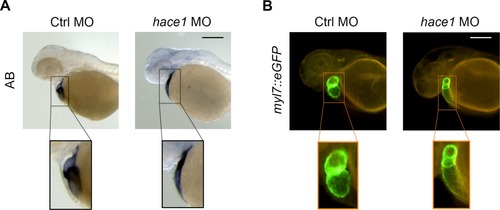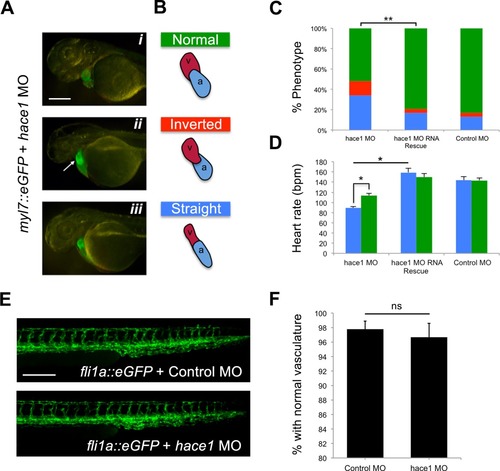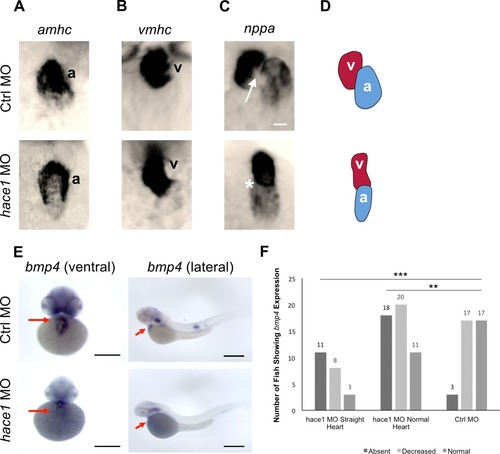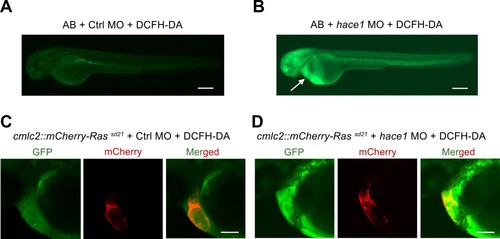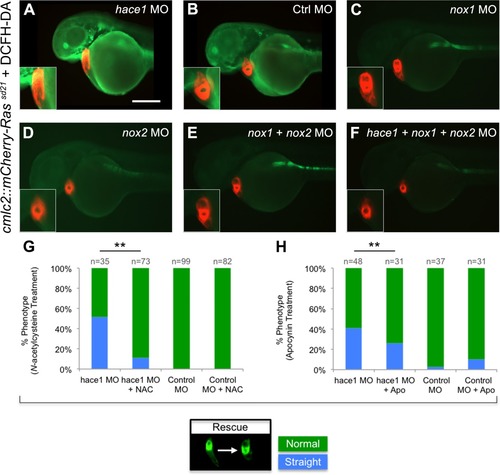- Title
-
hace1 influences zebrafish cardiac development via ROS-dependent mechanisms
- Authors
- Razaghi, B., Steele, S.L., Prykhozhij, S.V., Stoyek, M.R., Hill, J.A., Cooper, M.D., McDonald, L., Lin, W., Daugaard, M., Crapoulet, N., Chacko, S., Lewis, S., Scott, I.C., Sorensen, P.H.B., Berman, J.N.
- Source
- Full text @ Dev. Dyn.
|
hace1 knockdown results in a cardiac looping defect in zebrafish embryos. A: WISH of AB control and hace1‐morphant embryos at 48 hpf using the myl7 probe with magnified views shown in the boxes as indicated; lateral views. B: Fluorescence imaging of Tg(myl7::eGFP)‐morphant embryos at 48 hpf; lateral views. Scale bar, upper panels = 250 µm. PHENOTYPE:
|
|
hace1‐morphant embryos display specific cardiac phenotypes that can be rescued by human HACE1 mRNA while the vasculature remains intact. A: The looping defect that results from hace1 knockdown results in either misalignment of the atrium and the ventricle (the ventricle is located on the left side [white arrow], “inverted”) in ii or a tubular heart (“straight') in iii. Scale bar = 250 µm. B: Diagrammatic representation of each phenotype is included adjacent to a fluorescent image of a Tg(myl7::eGFP) hace1‐morphant embryo with the associated phenotype. C: Bar graphs showing the percent of each of the representative anatomic phenotypes shown in panels A and B (colors correspond to the respective phenotypes; n = 90–130 embryos for each group in 3 replicates; lateral views at 48 hpf; **P < 0.0001). D: Bar graphs showing the heart rate in hace1 and control morpholino‐injected embryos under the conditions indicated (n = 30–40 embryos for each group; * denotes a significant difference between the two groups of hace1 morphants, which also differ significantly with all other groups included in this panel at *P < 0.05). Movies capturing the differences in heart rates can be found in Supp. Movie S1. E: Fluorescence imaging of the 48‐hpf Tg(fli1a::eGFP) embryos injected with either control or hace1 morpholino demonstrates an intact vascular structure (lateral views) with a nonsignificant (ns) difference between the percentage of embryos with normal vasculature shown in F (n = 3, P > 0.05). Scale bar = 250 µm. PHENOTYPE:
|
|
hace1 knockdown results in more significant ventricular than atrial defects and a significant reduction in bmp4 expression. Ventral views from WISH of hace1‐morphant and control embryos using amhc (A), vmhc (B |
|
ROS levels are elevated throughout the embryo and in particular in the heart following hace1 knockdown. ROS is labeled by green fluorescence generated with oxidation of 2',7'‐ DCFH‐DA. A: AB embryos injected with control morpholino demonstrate baseline levels of ROS in the whole organism. B: AB embryo following hace1 knockdown exhibits elevated levels of ROS throughout the embryo, in particular in cardiac structures (indicated by the white arrow). Scale bar = 250 µm for panels A and B. C: Confocal imaging of Tg(cmlc2::mCherry‐Ras)sd21 embryo injected with control morpholino demonstrates a normal two‐chamber heart in red with baseline levels of ROS. D: Confocal imaging of Tg(cmlc2::mCherry‐Ras)sd21 embryo injected with hace1 morpholino demonstrates a cardiac‐looping phenotype and accumulation of ROS in the heart. Scale bar = 100 µm for panels C and D. All embryos are 48 hpf and visualized laterally. PHENOTYPE:
|
|
In situ hybridization, quantitative PCR, and RNA‐seq analysis demonstrate increased expression of rac1 in the absence of hace1. Ventral views of rac1 WISH in 48‐hpf casper control (A) and hace1‐morphant (B |

nox1 and nox2 knockdown or treatment with ROS and NADPH oxidase inhibitors rescues the cardiac phenotype by decreasing ROS levels. Lateral views of Tg(cmlc2::mCherry‐Ras)sd21 embryos stained with DCFH‐DA (5 μM) at 48 hpf following morpholino knockdown of hace1 (A), injection of control morpholino (B), morpholino knockdown of nox1 (C), nox2 (D), nox1/nox2 (E), and knockdown combination of hace1/nox1/nox2 (F). Co‐injection of hace1 MO + nox1/nox2 MOs rescues the abnormal cardiac phenotypes demonstrating the lowest levels of ROS and normal cardiac structure (F). Quantification of abnormal cardiac phenotypes in hace1 morphants following treatment with (G) NAC, ** P < 0.0001, and (H) Apo, ** P = 0.0098. The number on top of each bar represents the total number of embryos in the group. Scale bar = 250 µm. DCFH‐DA = 2',7'‐dichlorofluorescein diacetate. PHENOTYPE:
|

